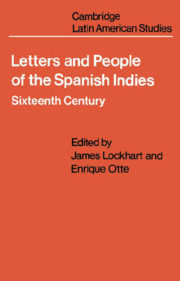Book contents
- Frontmatter
- Contents
- Preface
- Part I Conquest
- 1 Conquest in the personal view
- 2 A standard conqueror's report
- 3 The woman as conqueror
- 4 The merchant and the conquest of Peru
- 5 The merchant and the conquest of Mexico
- 6 The non-hero
- 7 The successful conqueror
- 8 The unsuccessful conqueror
- 9 The conqueror-governor
- 10 The conqueror in jail
- Part II The Variety of Life in the Indies
- Part III officials and Clerics
- Bibliography
- Index
10 - The conqueror in jail
from Part I - Conquest
Published online by Cambridge University Press: 06 August 2018
- Frontmatter
- Contents
- Preface
- Part I Conquest
- 1 Conquest in the personal view
- 2 A standard conqueror's report
- 3 The woman as conqueror
- 4 The merchant and the conquest of Peru
- 5 The merchant and the conquest of Mexico
- 6 The non-hero
- 7 The successful conqueror
- 8 The unsuccessful conqueror
- 9 The conqueror-governor
- 10 The conqueror in jail
- Part II The Variety of Life in the Indies
- Part III officials and Clerics
- Bibliography
- Index
Summary
Hernando Pizarro, in the fortress of La Mota in Medina del Campo, Spain, to his majordomo the priest Diego Martin in Peru, 1545
… Being in prison like this is the cause of it all …
As we said in introducing the preceding letter, royal officialdom did not take too active a hand with the governors who emerged from the expeditions of conquest. Letting nature take its course, however, led not infrequently to the ruling conquerors murdering and committing outrages on upstart subordinates or other rivals who threatened their jurisdictions. For these political crimes many were jailed and variously sentenced or deprived. Sebastian de Be nal cci.zar, for one example, died while appealing a death sentence for having executed a rival governor. While the early giants were thus at a disadvantage, their enemies would descend on them with claims and suits, and new powers would rise in the areas they ruled. The other side of the matter was the resilience of the apparently toppled great; even in jail they were powerful figures, and if not they, then generally their families long survived with wealth, influence and high title, though sometimes in Europe rather than in the Indies (as with both the Cortes and the Pizarro descendants).
We have just seen much of the background of the present situation in Letter 9. Hernando Pizarro, Francisco's haughty brother and right-hand man, led the forces that defeated Almagro, and it was Hernando who ordered Almagro's execution. Hernando then went off to Spain (sent by Francisco) to justify the action, with the result that he was kept in jail under various kinds of legal assault for over two decades. Here we see him after a reversal, but not humbled, still browbeating and mistrusting his employees, plotting to smuggle money from his large Peruvian estates into Spain, asking for documents which he hopes will throw the blame onto his now dead brother the Marques. Worse was yet coming for Hernando; just at this time his younger brother Gonzalo was leading Peru's most serious revolt to ultimate defeat. Nevertheless, Hernando eventually got out of prison, kept his estates in Peru and Spain, consolidated the family titles and entails, and established a lasting prominent position for the family in its ancestral Trujillo, Extremadura.
- Type
- Chapter
- Information
- Letters and People of the Spanish IndiesSixteenth Century, pp. 56 - 62Publisher: Cambridge University PressPrint publication year: 1976



